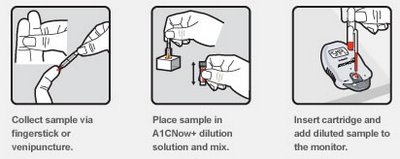 A glycated hemoglobin test (HbA1C or A1C for short) is a measure of blood sugar control during the past 2 to 3 months. Where a home blood glucose (BG) meter can tell you what your sugar is at a particular moment, an A1C test provides, in effect, an average of BG levels over the last few months.
A glycated hemoglobin test (HbA1C or A1C for short) is a measure of blood sugar control during the past 2 to 3 months. Where a home blood glucose (BG) meter can tell you what your sugar is at a particular moment, an A1C test provides, in effect, an average of BG levels over the last few months.The American Diabetes Association has a great fact sheet on the A1C test.
Both types of tests, BG self-monitoring and the A1C, are needed for effective control. Since the A1C is an average, it's not useful for making specific adjustments to your insulin or other treatments. Nor can it tell you if you've had very high or very low sugars recently. But it can pick up what's going on with your sugars in between the times you test, giving you a broader picture.
The A1C test was traditionally performed by a blood draw, with analysis either in a lab or doctor's office. The attractiveness of the newer at-home A1C tests, no doubt, factored into Bayer's recent acquisition of Metrika, manufacturer of the popular A1CNow+® meter:
"We are very excited to now offer people with diabetes and their healthcare providers the first and only device for use both at home as well as in the professional setting for monitoring of HbA1c."
- Sandra Peterson, President of Bayer Diabetes Care
The A1CNow+® test is similar, but not the same, as a BG test. It requires a slightly larger blood sample (5 microliters), takes 5 minutes to calculate results, and is performed in 3 steps:

- From Metrika's A1CNow+ Overview site.
The A1C Now+ is currently available in a 10-test-then-dispose version. Look for a 2-test version this fall.
Metrika's press release:
Bayer Acquires Metrika Inc.